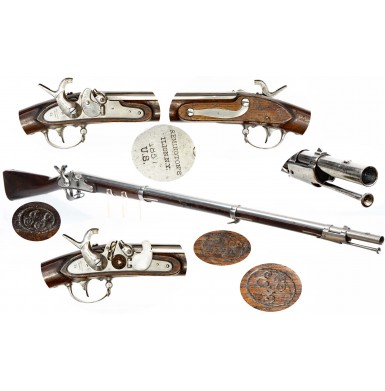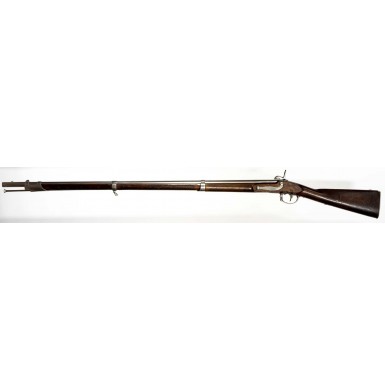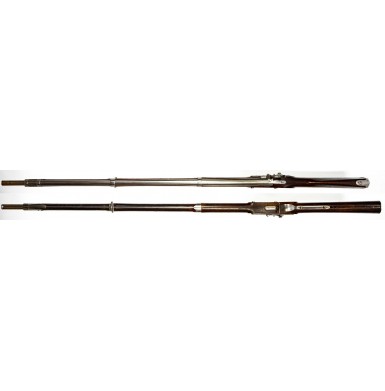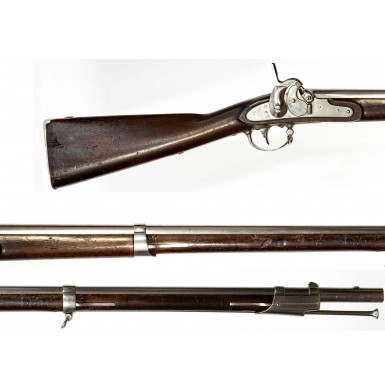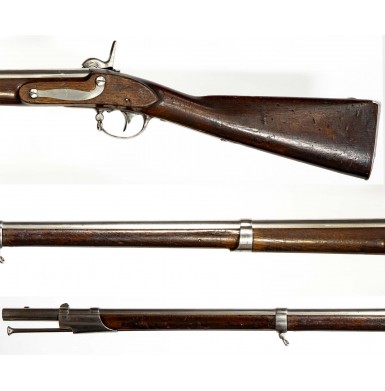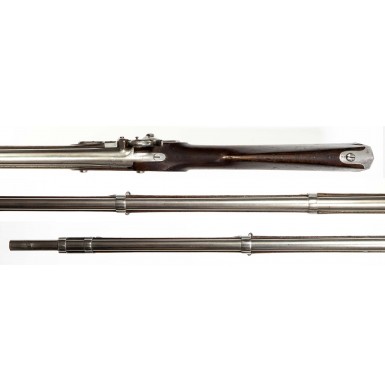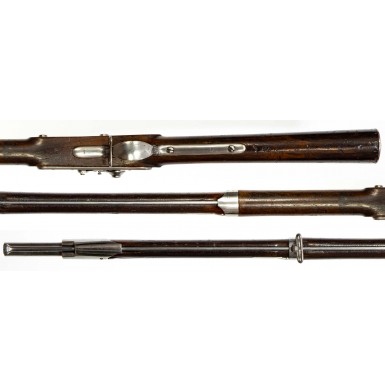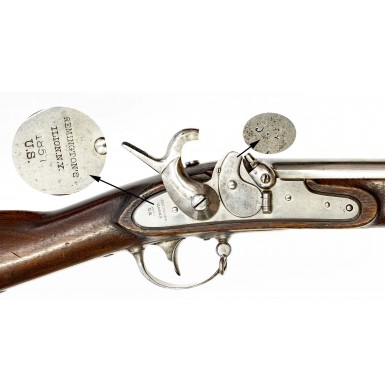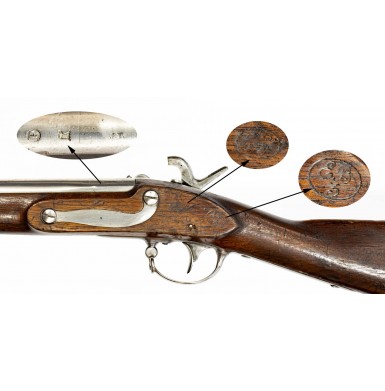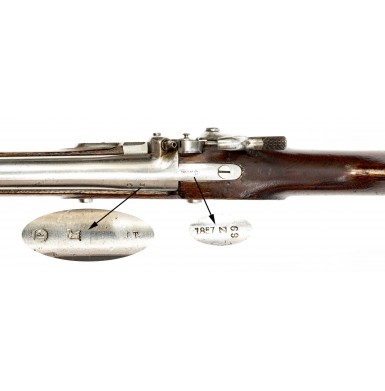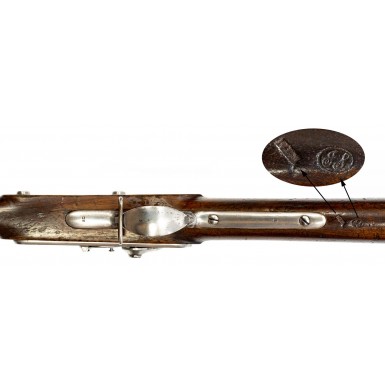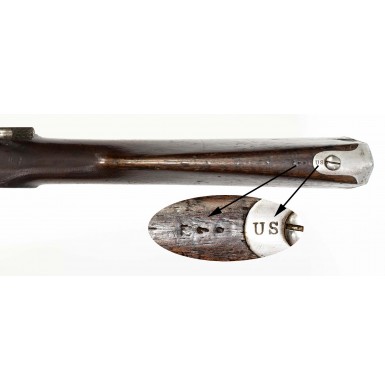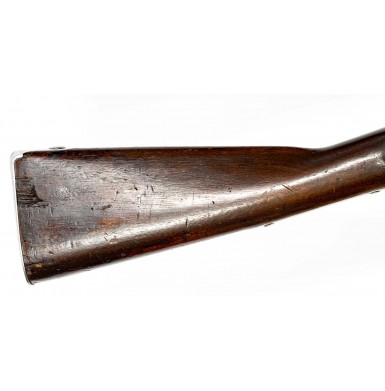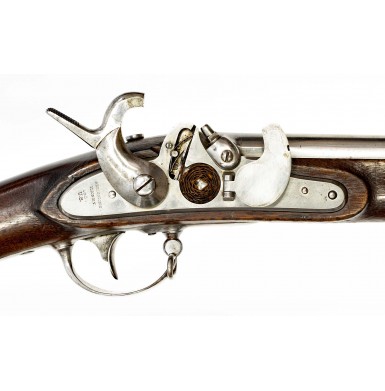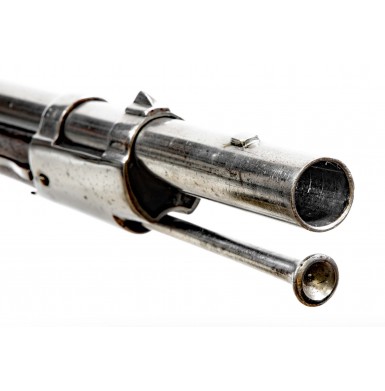Remington-Maynard US M1816 Frankford Arsenal Alteration Musket
- Product Code: FLA-3580-SOLD
- Availability: Out Of Stock
-
$1.00
This is about a FINE condition example of the US M1816/22 Musket converted to percussion by the addition of the Maynard’s Patent Tape Priming System. During the 1850s, the US Ordnance Department experimented with several automatic-priming systems, including those patented by Ward, Butterfield and Maynard. Both the Ward and Butterfield mechanical systems utilized a pellet or disc shaped primer pellet, similar to those used on the Sharps’ carbines and rifles equipped with the Lawrence automatic priming system. The Maynard system used a roll of “tape” with the priming compound sandwiched between two laminated layers of paper that were then coated with varnish to make them water resistant. These primer tapes resembled a modern child’s roll of caps for his toy gun. Two variations of the Maynard systems were actually implemented on a trial basis. The “Nippes-Maynard” system was first applied to Nippes contract US M1840 muskets that had yet to be delivered by Nippes, in addition to more Nippes contract US M1840 muskets store at the Frankford Arsenal. The alterations began during the fall of 1848 and over the next year Nippes would alter 2,000 US M1840 muskets to this variant of the Maynard priming system. These muskets were issued for trial purposes in lots of 200 and the response from the field was favorable enough that by 1854 it was proposed that a significant number of arms be altered with an improved version of the priming system.
The Nippes-Maynard alteration used a drum bolster conversion, mated with a modified lock that had a tape primer magazine added to the outside surface, in the general area that had originally contained the flintlock pan and battery. A specially shaped hammer was installed curved over the top of the tape primer magazine and engaged the percussion cone in the new drum bolster. This system had advantages and disadvantages. The primary advantage was that it used the existing lock with only added modifications and the use of a drum bolster was quick, simple and cheap. However, this system did not provide a strong enough breech for the use of expanding base Minié style projectiles in a rifled barrel, which created significantly more pressure than round ball or buck and ball loads in a smoothbore. The decision was taken to use a newly made steel chambered breech for the barrel alteration, which could withstand the pressures of firing Minié type ammunition from a rifled barrel. This necessitated the relocation of the tape priming mechanism from the exterior of the lock; as it had been on the Nippes alteration, to the interior, to better align the hammer with the bolster and barrel. The finalized design is what is known to today as the Remington-Maynard Tape Primer lock.
This new lock design would form the basis of the action for the new family of US M1855 small arms that was currently on the drawing board. After inquiring at Springfield Arsenal how long it would take to make a substantial number of the new locks and breech pieces, it was discovered that doing so would adversely affect the manufacture of the US M1842 muskets and M1847 musketoons, which were then in production there. The additional work would also delay the tooling up to produce the new M1855 series of arms. As a result, it was decided to contract with an outside supplier to have the locks and breeches manufactured and then installed at a secondary Federal Arsenal. In September of 1854 the Remington Arms Company entered into a contract to provide 20,000 sets of Maynard patent locks and the new chambered breech pieces to alter US M-1816/22 muskets currently in storage. The deliveries of the parts began in March of 1856 and continued through March of 1858. Remington delivered the components to the New York Arsenal and they were subsequently shipped to the Frankford Arsenal. In addition to altering the guns to the Maynard priming system they were also rifled, and the majority had long range rear sights and new, taller, iron front sights added. The original button head ramrods from the muskets were also modified, by dishing the button heads for use with elongated ammunition. The new front sights were produced at the Springfield Arsenal and it believed that Harper’s Ferry provided the M1855 pattern back sights. John Taylor, a Springfield Armory foreman who had supervised the manufacture of 6 pattern muskets for the alteration process was reassigned from inspection duties at Colt to the Remington factory to oversee and inspect the parts being made there. Between 1856 and 1859 a total of 21,952 US M-1816/22 muskets were altered at the Frankford Arsenal with the new, chambered breeches and Remington-Maynard locks. They also had their barrels rifled and their ramrods modified. Of those muskets most were equipped with long-range rear sights and new iron front sights. The 1,800 delivered in fiscal year 1856 were newly sighted as were the 8,137 delivered in fiscal year 1857. During fiscal year 1858 a total of 6,830 muskets were altered, but only 4,852 had the new sights added. Of the guns delivered during fiscal year 1858, 1,300 belonged to the state of New Jersey, 1,100 of which did not receive new rear sights, however 200 of the New Jersey guns did. During fiscal year 1859 the final 3,885 muskets were altered but did not receive sights. Of the 1859 guns, 678 were part of the original group of 2,000 guns sent from New Jersey for alteration. I can only assume that with the transition from the M1855 pattern sight to the M1858 pattern sight on the M1855 series of arms, that production of the earlier, “long range” sight with the long base ceased and no further sights were available for the alteration of the muskets. Considering the delay experienced at Harper’s Ferry transitioning between the two sight patterns and the number of 1855 rifles delivered without sights during the transition, the manufacture of sights for obsolete musket alterations was probably considered unimportant. In all a total of 19,974 muskets were altered to the Remington-Maynard system for the Federal Ordnance Department and 1,978 were altered for the state of New Jersey. All of the guns were rifled, but only 200 of the New Jersey guns received rear sights, while 14,789 of the Federal guns received new sights and 5,185 did not. Many of the muskets converted between 1855 and mid-1857 were issued to US Army troops at Fort Riley Kansas and to the US Navy. Some 4,000 were also shipped to California for issue from the Benicia Arsenal and around 1,000 were issued to the US Marine Corps. The balance of the guns were kept in storage at Frankford Arsenal with some 2,400 distributed to various Federal arsenals in different states. Some 396 were shipped to the San Antonio Arsenal and 400 were shipped to the Baton Rouge Arsenal. Many of these guns saw extensive use on both sides during the early days of the Civil War. The classic early war Confederate image of Private Thomas Taylor (Company F, 8thLouisiana Infantry) standing at parade rest in full field gear (including a great mix of English, CS and US accouterments) with his rifled & sighted US M1816 Remington-Maynard conversion musket is one of the best examples of where some of those guns ended up before the outbreak of the American Civil War. Taylor’s gun was almost certainly one of the 400 in storage at the Baton Rouge Arsenal when the Civil War erupted.
This is a FINEexample of a one of the 5,185 US M-1816/22 Remington Maynard Altered Rifled Muskets to be delivered without the long range rear sight. The gun remains quite crisp throughout with clear markings. The lock plate is clearly and crisply marked in four vertical lines behind the hammer:
Remington’s
Ilion N.Y.
1857
US
The date on the barrel tang is 1857 as well, and the tang is marked with the alphanumeric bayonet mating code Z 69. The original inspection marks from the initial production of the musket as a flintlock are still present on the barrel, a large depressed Pin an oval proof mark and a deeply struck Eagle Head. The new breech bears the small J.T. inspection mark of John Taylor, as does the upper edge of the outside of the tape primer door. The bottom edge of the outside of the door is marked T. The top of the stock comb, in front of the buttplate tang is stamped R 7 which was the Frankford arsenal reassembly code used during the alteration process, and the matching alphanumeric mark is present under the barrel. The upper barrel band is stamped on the right side with an old alphanumeric mating code Z 69, which mated a bayonet to the musket during its flintlock service life. The stock flat opposite the lock is stamped with the legible sub-inspection cartouche of Elisha Toby, a script ET in an oval. It is also marked with a very clear and crisp script re-inspection cartouche EB / 3, the mark of sub-inspector Elizur Bates, who rated the musket as “3rdClass” during the period of 1842-45 when all US flintlock muskets in service were rated as to their suitability for conversion to percussion. An equally crisp final acceptance cartouche is found in the stock behind the triggerguard, where a script JS indicates that Springfield Arsenal sub-inspector john Stebbins gave the final approval and acceptance of the musket when it was originally manufactured as a flintlock. As only “3rdClass” muskets were available for alteration by the time the Frankford Arsenal started the conversion process, the guns tended to be older (pre-1828) guns, usually produced by contractors. This musket was likely originally produced by Asa Waters, as both Toby and Stebbins inspected arms by that contractor.
The lock is mechanically excellent, and the tape-priming mechanism is 100% complete and fully functional. These muskets are often found with missing parts in the Maynard mechanism and it is nice find a complete one that works well. A partial roll of Maynard primers is present in the lock’s magazine as well. The metal of the musket has a lightly cleaned steel gray patina. The barrel is mostly smooth with some scattered light pinpricking present and as well as some scattered oxidized surface discoloration. Some small patches of more moderate pinpricking and very light are scattered here and there; most noticeably on the barrel bands. The barrels bands and buttplate also show some scattered, as well as some lightly oxidized surface roughness. The bore of the musket rates about VERY GOOD and is mostly bright and shiny with excellent rifling. The bore shows only some evenly scattered pinpricking along its length, and a few patches of light pitting along with some accumulated dirt and debris. A good scrubbing with a bronze brush would probably improve the bore to about excellent condition. The musket retains both sling swivels and the original, full-length ramrod is in the channel under the barrel. The rod retains excellent implement threads on its end and the end is appropriated dished for use with Minié ammunition. Even the screws retain traces of their original heat blued finish, the result of the drawing process. Most of the screws have a dusky bluish-gray patina, the remnants of their original blue. The upper band is mounted with the new iron front sight that was installed on nearly all of the Remington–Maynard altered muskets, but as noted no rear sight was ever installed. The stock of the musket rates about VERY GOOD+ to NEAR FINE. The stock is solid, full-length and complete, showing no breaks or repairs. The stock retains fairly crisp edges throughout with any rounding due to handling and use. There is a thumb sized surface chip of wood missing from the obverse butt at the buttplate. The stocks shows a moderate number of scattered bumps, dings and mars, and the ramrod channel shows the typical scattered minor chipping and slivering. The stock shows the expected wear and use for a gun that may well have seen Mexican War service in flint, as well as Civil War service with the automated tape primer mechanism.
Overall this is a FINE example of a very collectable and desirable US M-1816/22 conversion musket. The gun has very nice markings throughout and retains the entire complete and fully functional Remington Maynard lock. The gun is 100% complete, correct, original and unmolested and is one of only 5,185 altered for the US military that did not have a long-range rear sight installed. This musket has tons of eye appeal and a great overall look that displays wonderfully. This would be a top notch addition to any 19thcentury US marital long arms collection.
ON HOLD
Tags: Remington, Maynard, US, M1816, Frankford, Arsenal, Alteration, Musket

